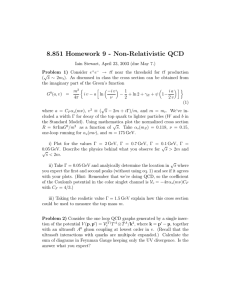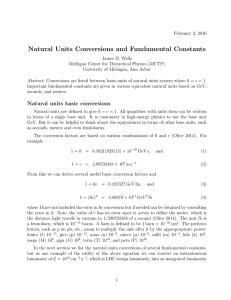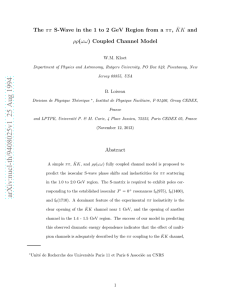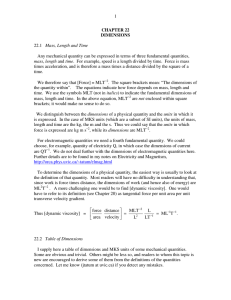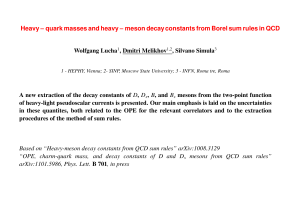problem5
advertisement
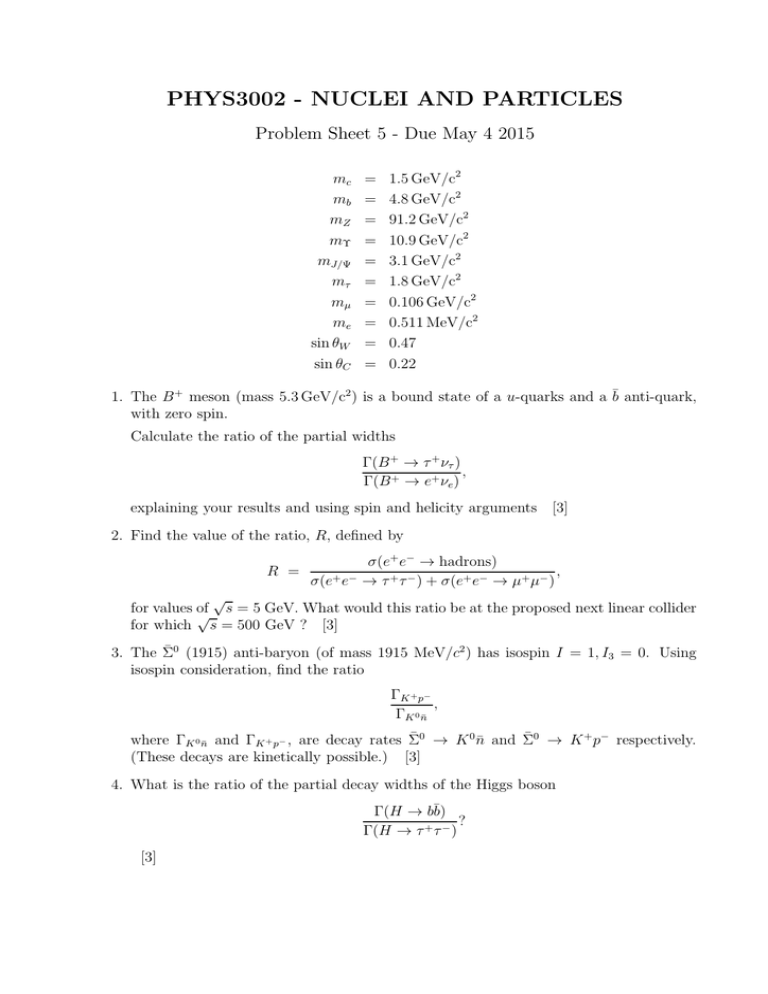
PHYS3002 - NUCLEI AND PARTICLES Problem Sheet 5 - Due May 4 2015 mc mb mZ mΥ mJ/Ψ mτ mµ me sin θW sin θC = = = = = = = = = = 1.5 GeV/c2 4.8 GeV/c2 91.2 GeV/c2 10.9 GeV/c2 3.1 GeV/c2 1.8 GeV/c2 0.106 GeV/c2 0.511 MeV/c2 0.47 0.22 1. The B + meson (mass 5.3 GeV/c2 ) is a bound state of a u-quarks and a b̄ anti-quark, with zero spin. Calculate the ratio of the partial widths Γ(B + → τ + ντ ) , Γ(B + → e+ νe ) explaining your results and using spin and helicity arguments [3] 2. Find the value of the ratio, R, defined by R = σ(e+ e− → hadrons) , σ(e+ e− → τ + τ − ) + σ(e+ e− → µ+ µ− ) √ for values of √ s = 5 GeV. What would this ratio be at the proposed next linear collider for which s = 500 GeV ? [3] 3. The Σ̄0 (1915) anti-baryon (of mass 1915 MeV/c2 ) has isospin I = 1, I3 = 0. Using isospin consideration, find the ratio ΓK + p − , ΓK 0 n̄ where ΓK 0 n̄ and ΓK + p− , are decay rates Σ̄0 → K 0 n̄ and Σ̄0 → K + p− respectively. (These decays are kinetically possible.) [3] 4. What is the ratio of the partial decay widths of the Higgs boson Γ(H → bb̄) ? Γ(H → τ + τ − ) [3] 5. Given the value for the running strong coupling at the Z-boson mass, αs (MZ c) = 0.12, determine the value of the running coupling, αs at • The Υ mass. (Υ is a b − b̄ bound state) • The 2 × mtop mass. [4] 6. Draw all the Feynman graphs for the q q̄ → ggg process. [3] 7. Find the ratio of KS (K short) in a beam of 10 GeV/c neutral kaons at a distance of 1 meter from where the beam is produced to the number of KL (K long) at a distance of 50 meters from where the beam is produced. (the life-times are τKL = 5 × ×10−8 sec, τKS = 0.86 × 10−10 sec, and the K 0 mass is MK 0 ≃ 0.5 GeV/c2 ). [3] Non-Assessed Questions 1. Describe qualitatively the Higgs mechanism by which particles acquire their masses and explain why this leads to the existence of the Higgs boson. 2. Explain, with the aid of Feynman graphs, why the data on the process e+ + e− → W + + W − confirmed that the photon and the Z-boson couple to W ’s. 3. Discuss two pieces of experimental data that support the idea that quarks come in three colours. 4. The graph of R, defined by R = σ(e+ e− → hadrons) , σ(e+ e− → µ+ µ− ) has a number of narrow peaks at various values of the centre-of-mass energy, Explain what these peaks are. √ s. 5. What is meant by fragmentation? Why do we know that this process must occur? 6. Explain, with the aid of Feynman diagrams, why the observation of three jet events in electron-positron annihilation was interpreted as evidence for the existence of gluons. Why is it that at high energies these events are rarer than two-jet events. 7. Explain what is meant by asymptotic freedom. What is the main difference between the interactions of gluons and the interactions of photons that leads to the result that QCD is asymptotically free, whereas QED (electromagnetism) is not? Explain how (the converse of) asymptotic freedom can lead to the idea of quark confinement. 8. What is meant by parity, charge conjugation, and CP? Explain why the particles K 0 and K 0 are not eigenstates of CP. Show that the superposition states 1 |KL i = √ |K 0 i + |K 0 i 2 1 |KS i = √ |K 0 i − |K 0 i 2 are eigenstates of CP. Explain why KL decays into three pions whereas KS decays into two pions. Explain qualitatively why a K 0 prepared at time t = 0 might transform into a K 0 at some later time. What decay channels distiguish between a K 0 and a K 0 ?

